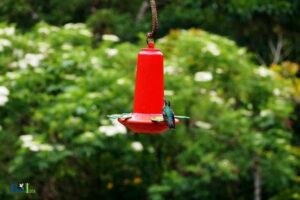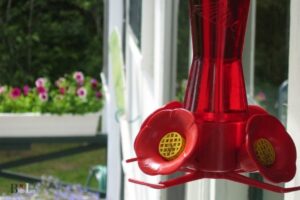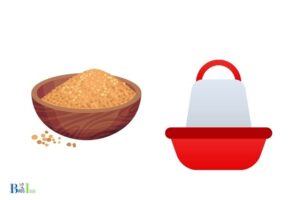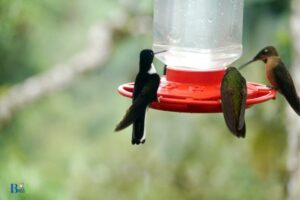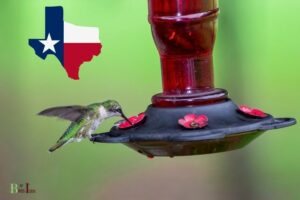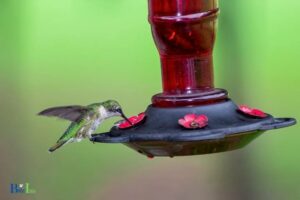When Do You Stop Feeding Hummingbirds in South Carolina?
In South Carolina, you should stop feeding hummingbirds around late October or early November when they begin their migration south for the winter.
Hummingbirds are seasonal visitors to South Carolina, typically arriving in the spring and staying throughout the summer. As temperatures begin to drop in the fall, they start their migration journey to warmer climates like Central or South America.
By providing food until they leave, you are not hindering their migration as some may believe. In fact, you are helping them maintain their energy levels for the long journey ahead.`
As the temperature starts to dip in the fall, keep an eye on the hummingbird activity around the feeders. Once you notice a significant decrease in activity, you can stop feeding and safely store the feeder until the next season.
Remember to clean and refill your feeder regularly to prevent the growth of mold and bacteria that could harm the hummingbirds.
12 Month Timeline for Feeding Hummingbirds in South Carolina
| Month | Feeding Status | Remarks |
| January | Continue Feeding | Although less active, some hummingbirds may still feed. |
| February | Continue Feeding | Hummingbirds may feed more as temperatures rise. |
| March | Continue Feeding | Spring migration begins; more birds may arrive. |
| April | Continue Feeding | Peak time for feeding as migration continues. |
| May | Continue Feeding | Feeding continues for both breeding and migrating birds. |
| June | Continue Feeding | Breeding season; continue providing food sources. |
| July | Continue Feeding | Breeding season continues; maintain feeding stations. |
| August | Continue Feeding | Peak time for feeding as southward migration begins. |
| September | Continue Feeding | Feeding continues as southward migration continues. |
| October | Continue Feeding | Migration continues; keep feeding until no birds are seen. |
| November | Consider Stopping | Migration ends; stop feeding if no birds are seen. |
| December | Optional | Feed only if overwintering hummingbirds are observed. |
Key Takeaway
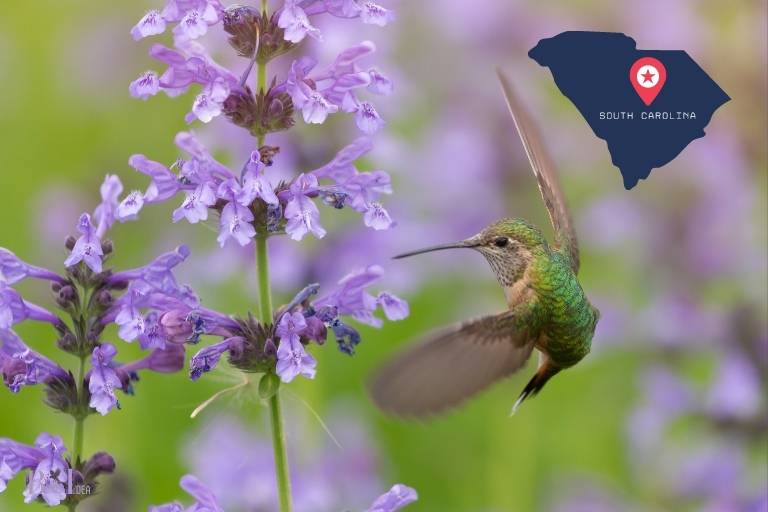
Five Facts About: Feeding Hummingbirds in South Carolina
The Fascinating World Of Hummingbirds
Hummingbirds are fascinating creatures that captivate many bird lovers in south carolina. While they may seem delicate, they are among the most resilient birds out there, with a long migratory journey spanning thousands of miles.
We take a deep dive into the world of hummingbirds, focusing on their life cycle, feeding habits, and migration patterns.
The Life Cycle Of Hummingbirds
Hummingbirds undergo a distinct life cycle, starting with mating and ending with their death.
Here are key points to better understand their life cycle:
- Hummingbirds typically mate during the breeding season, which occurs in south carolina between april and august.
- Once they reach sexual maturity, female hummingbirds lay 1-3 eggs in a tiny, cup-shaped nest made of spider webs and plant material.
- The mother hummingbird spends most of her time incubating the eggs, while the father keeps watch and brings her food.
The Feeding Habits Of Hummingbirds
Hummingbirds have an extremely high metabolism, with some species flapping their wings up to 90 times per second. They require a lot of energy to survive, which is why they are always on the lookout for food.
Here are some points to better understand their feeding habits:
- Hummingbirds mostly feed on nectar from flowers, but they also eat tree sap, fruit juice, and insects.
- To trap insects, hummingbirds hover in the air and snag them with their long beaks.
- Since hummingbirds have short legs, they can’t walk or hop on the ground. Instead, they can shuffle along a perch or push off with their wings.
- Hummingbirds have a unique tongue that can extend twice the length of their beaks, making it easier for them to reach the nectar of long-tubed flowers.
- Hummingbirds need to eat frequently, and they consume up to twice their weight in food per day during the breeding season.
The Migration Patterns Of Hummingbirds
Hummingbirds are known for their incredible migratory journeys that take them from south carolina to central and south america.
Here are some key points to understand their migration patterns:
- Most hummingbirds in south carolina migrate to central america, with some traveling as far south as bolivia and brazil.
- Hummingbirds start their migration in the fall, and it takes them several weeks to reach their destination.
- During their migratory journey, hummingbirds consume more food than usual to store up energy for their long flight.
- Certain species of hummingbirds, such as the ruby-throated hummingbird, fly non-stop across the gulf of mexico, which is approximately 500 miles wide.
- Hummingbirds return to south carolina in the spring, completing a round trip of over 5,000 miles.
Hummingbirds are amazing birds that have unique life cycles, feeding habits, and migratory patterns. Understanding these characteristics can help you better appreciate these tiny creatures and motivate you to create a hospitable environment for them in your backyard.
Understanding The Hummingbird Feeding Season
When Do You Stop Feeding Hummingbirds In South Carolina
Hummingbirds are fascinating creatures that bring life to any garden with their stunning colors and hypnotic fluttering.
They are known for their swift movements and high metabolism, which means they need to consume a lot of nectar to sustain their energy levels.
If you are a hummingbird enthusiast residing in south carolina, you might be wondering when to stop feeding hummingbirds. We will discuss the hummingbird feeding season in south carolina and give you a better understanding of when to expect these tiny creatures in your garden.
Timing The Hummingbird Feeding Season
To attract hummingbirds to your garden, it is essential to understand their feeding season. In south carolina, the hummingbird feeding season usually starts in april and ends in late september.
However, the timing can vary depending on the weather conditions.
Factors That Trigger The Start Of The Feeding Season
Several factors trigger the start of the hummingbird feeding season in south carolina.
These factors include:
- Temperature: The hummingbird’s metabolism is affected by temperature, and they require warm temperatures to survive. When the temperature rises, the hummingbirds start migrating from their wintering grounds and start searching for nectar sources.
- Daylight: Hummingbirds are diurnal creatures that are active during the day. In spring, the days start to get longer, which triggers their internal clock, and they know it’s time to start their breeding season.
- Flowering plants: The flowering plants start to bloom in large numbers during spring, producing nectar that attracts hummingbirds.
The Peak Of The Feeding Season
The peak of the hummingbird feeding season in south carolina is usually in july and august. During this time, you will observe a sudden influx of hummingbirds in your garden.
You will need to refill your feeders regularly as the hummingbirds consume a lot of nectar to fuel their energy requirements during their breeding season.
When To Expect Hummingbirds To Leave South Carolina
Hummingbirds start to leave south carolina in late september, and it is advisable to stop feeding them around this time. Continuing to feed hummingbirds after this time might interrupt their natural migratory patterns and delay their departure.
By this time, they have stored their energy and are looking for their wintering grounds.
Feeding hummingbirds is an enjoyable experience that requires some knowledge of their feeding season. Understanding their migratory habits and nectar requirements will help you attract and provide the necessary nourishment for these fascinating creatures.
Ensure that you stop feeding hummingbirds once they start migrating to give them the best chance of a successful journey.
Reasons To Stop Hummingbird Feeding
Migration Patterns Of Hummingbirds
Hummingbirds are known for their migration patterns, which differ from species to species. In south carolina, the ruby-throated hummingbird is the most commonly found species. They spend their winters in central america, mexico, and the west indies.
Ruby-throated hummingbirds typically start migrating during the late summer/fall season, usually around august and september.
Decline In Hummingbird Numbers In Late Summer/Fall
As the migration season approaches, hummingbird numbers in south carolina begin to decline. By the time fall arrives, many hummingbirds have already left the state.
Continuing to feed hummingbirds after the migration season has ended can be detrimental to their health.
The birds need to fly long distances to reach their wintering grounds, and excess weight can hold them back.
The Effect Of Food Availability On The Hummingbirds’ Health
It is crucial to provide a consistent source of food for hummingbirds during peak migration season. However, feeding hummingbirds outside this period, when food is widely available, can harm their health.
Providing an artificial food source during this time can cause hummingbirds to consume less nutritious natural nectar from flowers, resulting in poor health and reduced energy levels.
Feeding hummingbirds when they do not need to be fed can also cause them to become dependent on humans, which makes it difficult for them to survive in the wild.
As conservationists, it is our responsibility to ensure that we do not interfere with the hummingbirds’ normal migration and feeding habits.
Supporting Healthy Migration As A Conservation Measure
Providing a healthy feeding environment is critical to ensure that the hummingbirds continue to thrive, especially during migration season.
Supporting hummingbirds on their journey requires providing a healthy, consistent food source such as sugar water or nectar.
Moreover, reducing habitat loss and protecting important foraging and breeding sites can positively impact the populations of hummingbirds.
When we provide these important resources, we help ensure that these beautiful birds continue to grace our gardens and natural areas for generations to come.
How To Stop Hummingbird Feeding
Hummingbirds are lovely little creatures that grace our outdoor spaces with their beauty. These tiny birds are a joy to watch, as they move rapidly while feeding on nectar from flowers and feeders.
If you are living in south carolina and have been feeding hummingbirds, you might be wondering when to stop feeding them as the colder months approach.
Here’s what you need to know about how to stop hummingbird feeding.
Reducing Food Availability Gradually
Hummingbirds tend to be creatures of habit, and they will keep coming back as long as there’s food available. If you stop feeding them abruptly, you could disrupt their migration pattern and, in turn, affect their overall health.
Reducing food availability, gradually is the best approach when you want to stop feeding hummingbirds.
Here’s how to do it:
- Start by reducing the amount of nectar in your feeder by half.
- Wait for two days and replace the nectar with a mixture of one-quarter sugar and three-quarters water.
- After two more days, change the nectar ratio to one-part sugar and four parts water.
- Repeat the process until there’s no nectar left in the feeder.
Cleaning And Storing Feeders
Cleaning your hummingbird feeders is vital, not just for the health and hygiene of your feathered friends but also for the longevity of the feeder itself.
Here are some tips for cleaning and storing your feeders:
- Wash the feeder with hot water and soap at least once a week.
- Use a bottlebrush to scrub hard-to-reach areas.
- Rinse thoroughly with hot water to remove any soap residue.
- Allow the feeder to dry completely before refilling it with nectar or storing it away.
- Store feeders in a dry, cool, and shady place to prevent mold and mildew from developing.
Monitoring And Observing Hummingbirds As They Both Prepare For Migration And Feed Less Frequently
Hummingbirds have a delicate migration process that requires adequate preparation. As the colder months approach, hummingbirds will begin to feed less frequently and exhibit certain behaviors that indicate they are preparing to migrate.
Here’s what you need to observe:
- Notice the frequency of visits to the feeder. As the days get shorter, hummingbirds will tend to visit the feeder less frequently.
- You may notice that the hummingbirds are perching more often and grooming themselves for longer periods. This behavior indicates that they are preparing for the long journey ahead.
- Another sign that they are preparing to migrate is when the birds start eating more insects and less nectar. This behavior is a natural way for hummingbirds to fuel up on protein for the long journey ahead.
Keeping The Environment Suitable For Hummingbirds During Migration
Creating a suitable environment for hummingbirds during migration is essential for their survival.
Here are some tips for helping hummingbirds during this time:
- Keep your garden equipped with nectar-rich flowers such as bee balm, cardinal flowers, and salvia.
- Ensure that the flowers are blooming in both the spring and fall seasons.
- Offer a water source for hummingbirds to bathe and drink from.
- Keep your feeders up until you notice that the hummingbirds have left for their migration journey.
As the temperatures start to drop, hummingbirds will begin their migration towards warmer climates. Following these tips and guidelines, you can help the hummingbirds complete their journey safely while enjoying their company in your garden.
FAQ On When Do You Stop Feeding Hummingbirds In South Carolina
What Is The Best Time To Stop Feeding Hummingbirds In South Carolina?
Can Feeding Hummingbirds Year-Round Harm Them In South Carolina?
Do Hummingbirds Become Dependent On Feeders In South Carolina?
What Are The Signs That It Is Time To Stop Feeding Hummingbirds In South Carolina?
Conclusion
As the temperature drops in south carolina, hummingbirds begin their migration southwards, signaling the end of their feeding season.
While you may be tempted to continue feeding them to support their journey, it’s important to understand that keeping your feeders up too long can cause harm to the birds.
Cold temperatures and lack of food can cause them to delay their migration or become more susceptible to disease. To ensure the safety and well-being of these delicate creatures, it’s advised to stop feeding hummingbirds in south carolina by early october.
Instead, focus on providing natural sources of food, such as flowers, to support their journey. By understanding the appropriate feeding time and taking necessary steps to support them during their migration, we can do our part to help these incredible birds thrive.
Let’s show them our love and respect while creating a sustainable environment for them to flourish and prosper.

